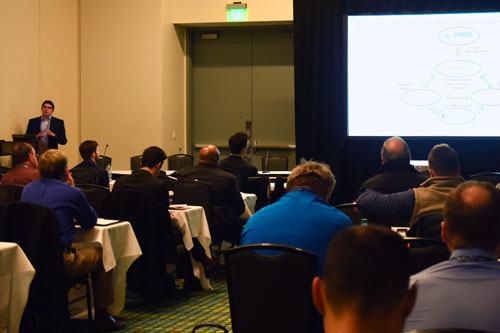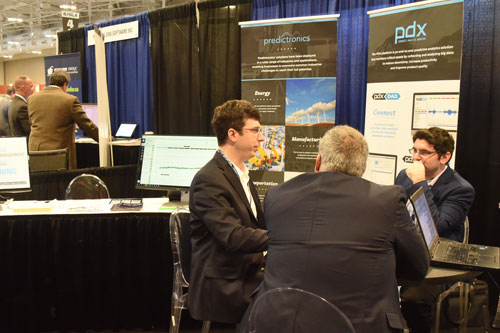
FOUR TAKEAWAYS FROM DMC 2018
DECEMBER 11, 2018
Predictronics had a successful experience at the Defense Manufacturing Conference in Nashville, Tennessee from December 3rd-December 6th.
The purpose of the DMC was to create an environment for solutions providers to learn more about defense manufacturing in order to better understand industry needs and improve collaboration with one another. These engagements will lead to higher productivity and production quality in manufacturing operations. Predictronics not only exhibited our PDX platform and our Factory Sentinel for Industrial Robots software at the conference, but CTO Dr. David Siegel also presented our collaborative research project with DMDII, Northeastern University, Lockheed Martin, and FORCAM. This project, titled Achieving Smart Factory through Predictive Dynamic Scheduling, creates an integrated dashboard for machine health and overall equipment effectiveness (OEE), improving predictive factory environments, reducing unexpected downtime, and saving manufacturers time, money, and resources.
Predictronics not only exhibited our PDX platform and our Factory Sentinel for Industrial Robots software at the conference, but CTO Dr. David Siegel also presented our collaborative research project with DMDII, Northeastern University, Lockheed Martin, and FORCAM. This project, titled Achieving Smart Factory through Predictive Dynamic Scheduling, creates an integrated dashboard for machine health and overall equipment effectiveness (OEE), improving predictive factory environments, reducing unexpected downtime, and saving manufacturers time, money, and resources.
Representatives and speakers from over 650 organizations and businesses were in attendance, including GE Aviation, Boeing, Lockheed Martin, and the United States Army, Navy, and Air Force.
Here are Dr. Siegel’s top four takeaways from the conference:
- Common key technology drivers in the field of defense manufacturing match those of other industries.
Throughout the conference, a collective set of technologies were identified as critical to defense manufacturing. Some of the major topics included additive manufacturing, advanced analytics, cyber security, robotics, and automation.
These areas are mutually shared themes in other manufacturing sectors, such as automotive manufacturing. This is excellent for solutions providers, as we can provide impactful products and services in defense manufacturing applications without having to make further additions and customizations to our established technologies.
A common interesting perspective arose from the conference keynote talks. Many mentioned the notion that science fiction has inspired the vision for technology, from robotics and transportation to communication and medicine. While these are buzzworthy notions, there is actually very little in science fiction that shows a futuristic view of a next-generation factory. - There was a great deal of interest in obsolescence management and predictive quality.
Obsolescence management and the relationship between manufacturing processes and product quality were popular themes amongst conference attendees.
 Many manufacturers of electronic components acknowledged the importance of obsolescence management in various defense and aerospace platforms, as there is often a long lifespan for these respective platforms. An interesting challenge facing solutions providers is figuring out how to further develop predictive analytics for life prediction and how to integrate those capabilities with existing software for obsolescence.
Many manufacturers of electronic components acknowledged the importance of obsolescence management in various defense and aerospace platforms, as there is often a long lifespan for these respective platforms. An interesting challenge facing solutions providers is figuring out how to further develop predictive analytics for life prediction and how to integrate those capabilities with existing software for obsolescence.
Regarding predictive quality, most attendees understood how sensors on machines could be combined with advanced analytics to monitor the health of factory equipment. However, many were eager to learn the relationship between monitored process variables, output quality metrics, and upstream factors, such as material properties, for the purpose of predicting quality. The concept of predictive quality is more challenging than that of predictive maintenance, although through greater understanding and use of analytics in defense manufacturing, developers can reduce quality issues and save lives, resources, time, and money. - Artificial intelligence and machine learning can be used to find the link between design, manufacturing, and product usage.
Feeding information from the manufacturing process and product usage back into design was a topic of prominence at this conference.
Hopefully, gaining the ability to more easily extract CAD and CAE data, greater IOT enabled manufacturing equipment and processes, and better managed usage and sensor field data will allow for more research and innovation in manufacturing design. - Many have now realized the importance of combining predictive maintenance, maintenance scheduling, and OEE.
Predictive maintenance and OEE monitoring are in separate data silos and software systems, however by further enhancing and integrating these complimentary systems, one would be given more insight on their manufacturing equipment and process. Maintenance scheduling driven by the output from predictive health monitoring offers an exciting new development, since it provides the user with actionable information on when to order spare parts and when to perform maintenance to both prevent failures and extended downtime related to unavailability of spare parts.
Data visualization is nice, but without actionable information, defense manufacturers will not fully realize the benefits of their predictive maintenance system.
For more information and weekly updates, follow Predictronics:
Know What Happens Next with PDX!
TRY IT TODAY

